What to do if onions rot in the garden and why this happens
Often gardeners are faced with the problem of rotting onions. Plants take on a sick appearance, and the harvest disappears before our eyes. Methods for solving the problem are selected depending on the causes of this phenomenon. A timely solution to the problem will save the harvest. Why onions rot in the garden and what to do about it, we will tell you in the article.
For what reasons do onions rot in the garden?
Most causes of onion rot are soil related. Early identification of negative factors will save harvest from death.
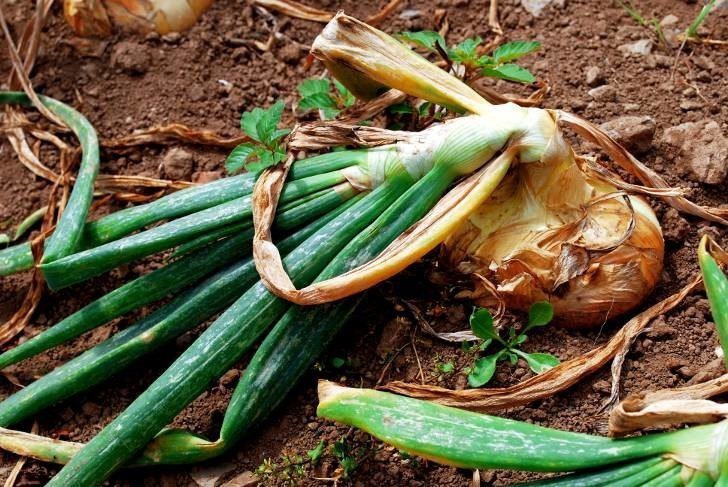
Excess moisture
Excessive soil moisture is detrimental to the plant. Be sure to monitor this indicator and do not water too often. Constant rains also cause waterlogging of the soil. In this case, they think in advance about draining excess liquid from the beds using drainage in the form of expanded clay or coarse sand, which is added to the soil before planting.
Failure to comply with crop rotation
Growing onions in one place from year to year is unacceptable - this leads to the accumulation of pathogenic microorganisms and pests in the soil. When planting, they enter the plant through the soil and begin to destroy it.
Reference. Lack of crop rotation leads to impoverishment of the land. The plant lacks minerals, which provokes the process of rotting.
Excess nitrogen in the soil
Onions need nitrogen at the beginning of growth. This promotes the growth of green mass. In the future, the plant does not need it and remains in the soil. Application of complex fertilizers, which contain nitrogen, will lead to its accumulation in the soil. Excess microelement will soften the bulbs. Later they will begin to rot.
Infected planting material
Signs of infected planting material:
- the upper scales are wet;
- the set has an uncharacteristic odor;
- covering husk of irregular color;
- There are visible lesions on the head and bottom of the onion.
Diseases
Rotting processes are caused by the development of bacterial or fungal infections. Provoking factors are wet weather, high soil moisture, improper care.
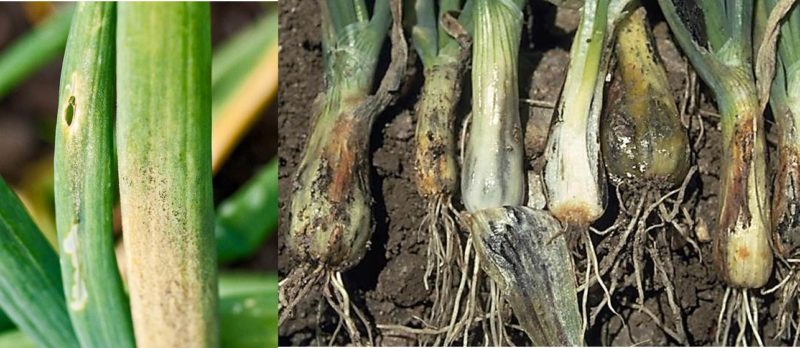
The plant is mainly affected by the following diseases:
- Cercospora - fungal disease of onion feathers. Characterized by the appearance of clear gray spots with a thin yellow border. When neglected, the leaves turn yellow and die.
- Cervical rot - fungal disease. It starts from the neck of the bulb. The scales become wrinkled, and the inner layer rots, becoming covered with a gray coating with black dots. When cut, the onion has a boiled appearance.
- White rot - fungal infection. Develop at temperatures +20…+24°C. Yellowing and subsequent death of leaves is characteristic. The onion quickly withers and dies. A fluffy coating and soft rot form on the roots.
- Powdery mildew - a fungal infection starting on the outside of the feathers. The plant becomes exhausted and dies. The stems are covered with brown spots.
- Fusarium rot - a fungal infection that enters the plant from the soil: first on the roots, then upward on the head and feathers. This is the rarest reason why the bottom of an onion rots and it becomes watery.
Pests
The main damage to the crop is caused by:
- Onion flies. The insect is 6-8 mm long and light gray in color. Externally similar to house flies.The plant slows down, the feathers turn yellow, wither, and dry out. Onions give off an unpleasant odor.
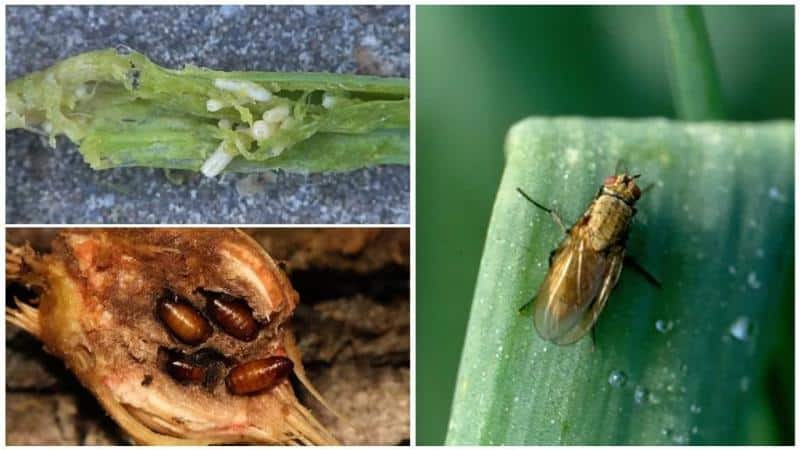 Onion fly
Onion fly - Stem and bulb nematodes. Small worms that live in the top layer of soil. The plant slows down in growth, the process of rotting of feathers, stems and roots begins.
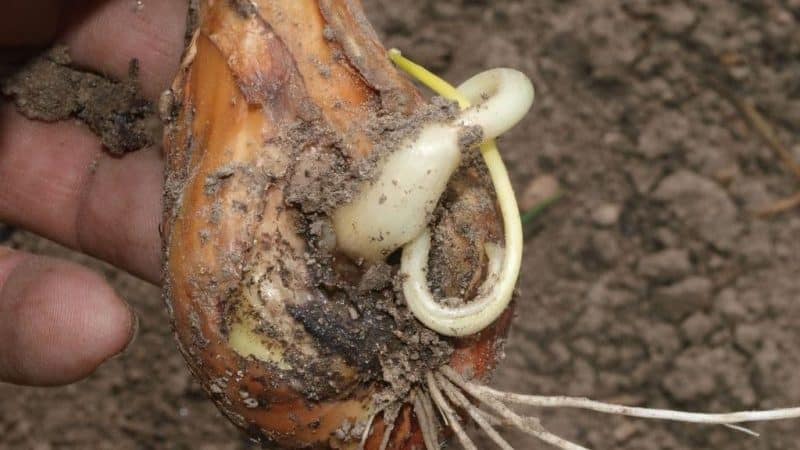 Onion nematode
Onion nematode - Weevils. Insects with a black, strong, convex body up to 2-2.7 mm long. At the initial stage, the leaves are affected. After 14-20 days, they descend into the ground through the gnawed feathers to lay eggs.
How to deal with rotting
The choice of treatment method depends on the extent of the damage. At the initial stages, folk methods of combating onion rotting are effective. In advanced cases, chemicals are used.
Traditional methods
Publicly available methods of control are used in the initial stages of the disease. They are easy to use and safe.
In rainy weather, the beds are covered with film. This reduces soil moisture. The second method is drainage in the form of a layer of sand or expanded clay at the bottom of the bed.
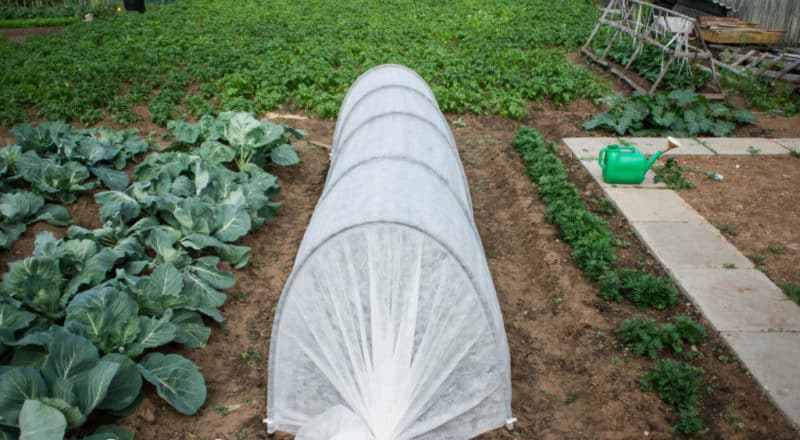
The amount of nitrogen in the soil is reduced by reducing watering. Observe the frequency of application of nitrogen, potassium and phosphorus. Nitrogen forms a juicy feather, phosphorus - a strong onion head. Potassium improves taste, increases shelf life and resistance to pests.
Application:
- Nitrogen is applied at the beginning of the growth period, in the phase of 1-2 leaves. To do this, dissolve 10 g of urea in 10 liters of water and water the bed immediately after planting the onions.
- Phosphorus is added in the middle and end of growth. To do this, take 20 g of superphosphate and dilute it in 10 liters of water.
- Potassium is fertilized during planting (half the norm), the rest is divided into 2 times and applied in the middle and end of the period growing. At the beginning of the season, 20 g of potassium sulfate is mixed with 10 liters of water. In the fall, after harvesting, add a solution of 12 g of potassium chloride and 10 liters of water.
Disease Control:
- Cercospora infection is treated with an infusion of fermented herbs. It is prepared by steaming 1/2 a bucket of chopped herbs with boiling water. The mixture is left for several days. Then filter and water the beds 2 times with a break of 2 weeks.
- White rot is treated with whey (1.5 tsp of copper sulfate and 3.5 l of water are dissolved in 1.5 liters). The resulting mixture is used to water the beds once every 14 days until the signs of damage disappear.
- Wood ash helps in the fight against powdery mildew. 2 tbsp. pour 2 liters of boiling water, infuse, filter. Dissolve it in a bucket of water and spray the beds. An infusion of herbs used to combat cercospora also helps. A solution of 100 g of raw material per 1 liter of water has a detrimental effect on fungal spores. Apply the product once every 14 days until signs of damage disappear.
- The weevil is removed using burlap, cut into strips 10 cm wide. In the evening they are laid out around the bulbs, removed in the morning - the pest will get entangled in them.
Chemical
Insecticides are effective when the lesion reaches a critical stage. The drugs will cope with pests and will allow you to save the harvest. The main condition is to follow the dosage:
- For cercospora and powdery mildew, Fitosporin is used. 10-15 g of powder are diluted in 10 liters of water. Spray the crops at intervals of 14 days. In rainy weather, treatment is carried out once a week.
- White rot can be treated well with Fundazol. 10 g of the drug is dissolved in 10 liters of water and the beds are watered once every 14 days.
- Cervical rot is treated with Bordeaux mixture - 100 g per 10 liters of water. The resulting mixture is used to water the beds once.
- They fight onion weevil with Karbofos - 60 g of the drug per 10 liters of water. Spray the beds once during the growing season. The prepared mixture is designed to process 10 square meters. m.
Prevention measures
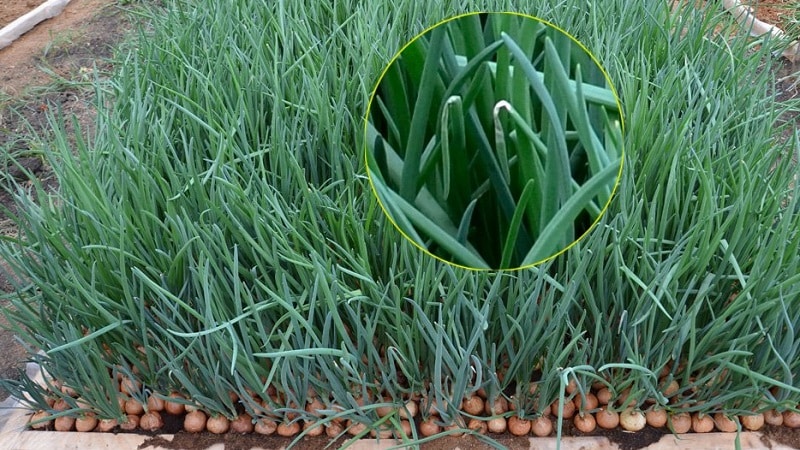
Prevention measures include:
- Maintaining crop rotation. Onions are planted in their previous place no earlier than after 3-4 years.
- Selection of varieties resistant to diseases. These include Supra, Farmer Late, Stardust F1, Comet, Goliath, Erica, Stutti, Sterling F1.
- Treatment of seeds and soil before sowing. The beds are doused with boiling water and covered with film for 4 days. Before planting, water with “Fitosporin” (10 liters of water per 5 g of powder). The bulbs are soaked for an hour in a warm (+45°C) pink solution of potassium permanganate.
- Loosening and weeding is carried out every 2 weeks.
- Planting carrots and fragrant tobacco as neighbors (will save you from onion flies), calendula, marigolds and nasturtium (will protect you from nematode infection).
Conclusion
Among the main reasons for onion rotting in the garden are high humidity, poor crop rotation, excess nitrogen in the soil, and contaminated planting material. When fighting diseases and pests, traditional methods and chemicals are used. The first option is effective in the early stages, chemicals are used in the later stages. By following simple preventive measures, rotting is easy to avoid.